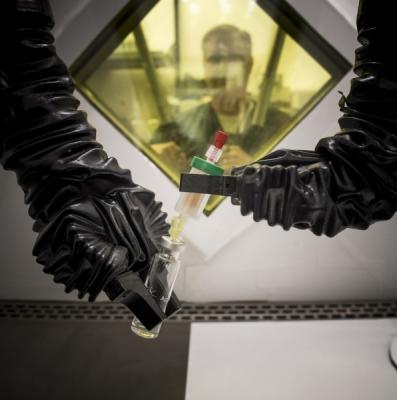
Image courtesy of the University of Alabama at Birmingham
August 27, 2019 — The University of Alabama at Birmingham, in conjunction with researchers at the University of Wisconsin and Argonne National Laboratory in Illinois, have received a Department of Energy grant to solve a production roadblock for the radioactive isotopes 43Sc and 47Sc. These radioactive isotopes of the metallic element scandium (Sc) appear to be ideal for visualizing and then destroying solid tumors. A barrier, however, blocks their use — the inability to rapidly produce and purify the isotopes in useful amounts. 43Sc has a half-life of 3.9 hours, so every four hours more than half the radioactivity is lost. It must be used in a positron emission tomography (PET) scan the same day it is made.
43Sc and 47Sc are a sought-after “theranostic” pair, said Suzanne Lapi, Ph.D., director of the UAB Cyclotron Facility, professor in the UAB Department of Radiology and leader on the grant.
Both 43Sc and 47Sc, if available, would be attached to a targeting peptide to guide them to a solid tumor for imaging and for tumor eradication. 43Sc would allow a diagnostic scan because it emits positrons, resulting in gamma radiation that would travel out of the body for detection and size measurement by a PET scan. 47Sc would deliver the therapy at the tumor by emitting a tissue-damaging beta particle.
The Lapi lab at UAB used the UAB cyclotron — a key machine for the development of advanced cancer diagnosis and treatment at the O’Neal Comprehensive Cancer Center at UAB — for preliminary work on how to make the theranostic pair.
They found that protons, fired from the particle accelerator, formed Sc isotopes when using titanium oxide targets. Shaun Loveless, a graduate student in the Lapi lab, also developed a purification scheme — target titanium oxide was dissolved in acid and ammonium bifluoride and poured through an ion exchange column to separate Sc from titanium.
Because natural titanium is a mixture of five stable isotopes, these preliminary experiments did not yield pure 43Sc and 47Sc. Proton bombardment of natural titanium produced additional, contaminating Sc isotopes. The next step will use targets that are single stable isotopes of titanium, not a mixture.
Researchers at UAB, Wisconsin and Argonne have planned a multipronged production effort. UAB will use its 24 MeV cyclotron to irradiate titanium-46 and titanium-50 targets with protons. Wisconsin will use its 16 MeV cyclotron to irradiate calcium oxide targets with deuteron particles, made of one proton and one neutron. Argonne will irradiate titanium targets with gamma rays.
All three labs will work together, at small scales, to perfect the purification of 43Sc and 47Sc from the target materials.
Lapi said UAB’s targeting expertise and its powerful cyclotron helped the university compete for the $390,000 research grant. She also said all three sites will involve graduate students in collaborative training and research, which is a goal of the Department of Energy to prepare the future workforce.
The UAB Cyclotron Facility has national recognition. It produces zirconium-89 and other isotopes for clinicians and researchers at institutions that include Stanford University, the University of California, MD Anderson Center in Houston, the University of Pennsylvania, Yale University and Memorial Sloan Kettering Cancer Center in New York.
Funding for this isotope production research comes from Department of Energy Isotope Program grant DE-SC0020197. The federal Isotope Program supports development of production techniques for radioactive and stable isotopes that are in short supply for research and have strategic importance to the nation.
In the UAB Department of Radiology, Lapi is also vice chair of Translational Research, director of the Radiochemistry Laboratory and division director of Advanced Medical Imaging Research. She is also a senior scientist in the O’Neal Comprehensive Cancer Center at UAB.
For more information: www.uab.edu


 November 18, 2025
November 18, 2025 









